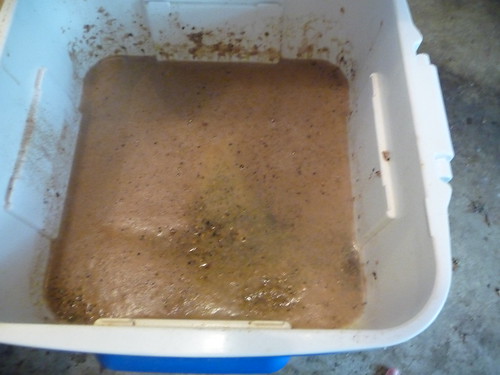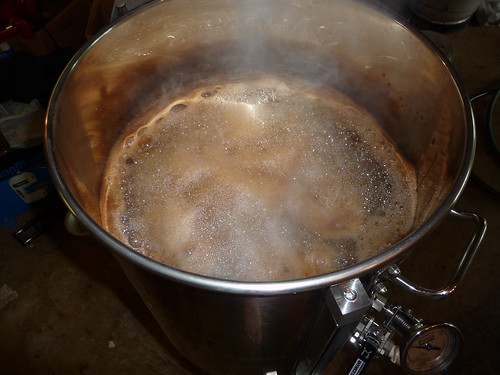 If you look around on just about any homebrewing forum online, and just about any of the good brewing books, you'll eventually run across assorted discussions on water. Water is the primary ingredient in beer, and has all sorts of impacts on just about every aspect of brewing, from mash chemistry to off flavors. The water at my parents' house is really tasty and really hard. I've still yet to get it tested, though I am tempted to do that now, since I have some extra around today. I do know that it's from a deep well on a mountain where the majority of the rock is limestone. I also know that it makes excellent stouts. I try to use their water for as many of my dark beers as possible.
If you look around on just about any homebrewing forum online, and just about any of the good brewing books, you'll eventually run across assorted discussions on water. Water is the primary ingredient in beer, and has all sorts of impacts on just about every aspect of brewing, from mash chemistry to off flavors. The water at my parents' house is really tasty and really hard. I've still yet to get it tested, though I am tempted to do that now, since I have some extra around today. I do know that it's from a deep well on a mountain where the majority of the rock is limestone. I also know that it makes excellent stouts. I try to use their water for as many of my dark beers as possible.Milk sickness is caused by cows eating White Snakeroot, and then nursing their young, who then get sick and sometimes die from the milk. The active chemical that causes milksickness is Tremetol. White County, TN was apparently pretty rough on cattle back in the day, between Milksick Mountain and the Calfkiller River. So, as a sort of tribute to the place where the water is coming from, I'm working on a series of stouts brewed with water from Milksick Mountain. I brewed the first one earlier this year, and it's currently cold-conditioning in the keg. My goal was to use the same grain bill with each of them and vary the yeast, adjunct sugars, and aging process.
 Unfortunately, for this one, I forgot to check on my flaked (i.e. old fashioned) oat supply, so I've replaced half of the oats with flaked barley, as that should help with the thick/slick mouthfeel. I found sour cherry concentrate at Kroger a few weeks ago, so I thought I would alter this recipe somewhat and go for a cherry stout. The amount of cherry concentrate that I'm using should work out to the equivalent of a little more than 3lbs/gallon of cherries. The cherry may be overpowering... I'm also decreasing the hops a bit, to make up for the fact that I'm adding sour cherries, as the sour and bitter may not go very well together. I'm using the Wyeast 3787 Belgian Trappist yeast (Westmalle, Westvleteren, etc.), which I've done in a stout-like beer before and it turned out really tasty, hopefully the flavors from it don't conflict with the cherry. I'm also pitching a little bit of Fermentis Safbrew T-58, because I forgot to make a starter for the 3787 last night, and I only need half a pack for the Berliner Weisse from Saturday.
Unfortunately, for this one, I forgot to check on my flaked (i.e. old fashioned) oat supply, so I've replaced half of the oats with flaked barley, as that should help with the thick/slick mouthfeel. I found sour cherry concentrate at Kroger a few weeks ago, so I thought I would alter this recipe somewhat and go for a cherry stout. The amount of cherry concentrate that I'm using should work out to the equivalent of a little more than 3lbs/gallon of cherries. The cherry may be overpowering... I'm also decreasing the hops a bit, to make up for the fact that I'm adding sour cherries, as the sour and bitter may not go very well together. I'm using the Wyeast 3787 Belgian Trappist yeast (Westmalle, Westvleteren, etc.), which I've done in a stout-like beer before and it turned out really tasty, hopefully the flavors from it don't conflict with the cherry. I'm also pitching a little bit of Fermentis Safbrew T-58, because I forgot to make a starter for the 3787 last night, and I only need half a pack for the Berliner Weisse from Saturday.Milksick Stout: Tremetol B
Batch Size (Gal): 5.5
Total Grain (Lbs): 19.00
Anticipated OG: 1.086
Anticipated SRM: 61.5
Anticipated IBU: 50
Wort Boil Time (min): 60
Grain
68.4% -- 13.00 lbs. Canada Malting Pale Malt
5.3% -- 1.00 lbs. Flaked Barley
5.3% -- 1.00 lbs. Flaked Oats
5.3% -- 1.00 lbs. Roasted Barley
3.9% -- 0.75 lbs. Chocolate Malt
3.9% -- 0.75 lbs. Pale Chocolate Malt
7.9% -- 1.50 lbs. Fruit Fast Montmorency Tart Cherry Concentrate
Hops
1.50 oz. Centennial (Pellet, 8.80% AA) @ 60 min.
Yeast
Wyeast 3787 - Trappist High Gravity
Fermentis Safbrew T-58
Water Profile
Milksick
Extras
11 drops Fermcap-S
Notes
- Brewed on Saturday, May 2, 2011
- Actual OG: 1.074
- 6:00 PM, 68F pitched full pack of 3787 and ~6g of T-58
- Fermentor is wrapped in a blanket, and the temperature controller is attached, but the intention is o let it go to whatever temperature it wants to go to, and I'll just hold it at that final temperature for a few days after the fermentation is finished.
- May 3, 7:00 AM, still 68F, 1.5 inch kraeusen on top. replaced airlock with blowoff tube, just in case
- May 3, 5:00PM, 72F. Apparently Fermcap is no match for WY3787. Blowoff tube was a good choice.
- May 4, 6:00AM, 80F.
- I never actually applied heat to this beer until it started cooling off. The beer peaked at 81F on May 4. Since then, I have held it steady at 80F, so that the yeast can finish out. This is a similar temperature to where Westvleteren ferments with this yeast, and around where I did my Dubble-Weizen last year, so it should be just fine.
- I killed the heat after the beer had been in the fermentor for 10 days or so.
- Thursday, May 26, I heated 1.5oz Medium toast Hungarian Oak cubes in 1/2 cup distilled water in the microwave for 3 minutes. Then added them to a secondary fermentor and racked the beer onto them. This will sit in the cellar for at least a month.

No comments:
Post a Comment